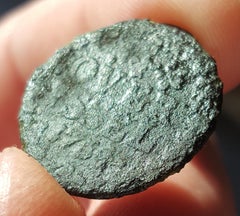(Silver) Coins
On every field you will definitely find coins of some kind. Through all past centuries these are the items that would always be around - from the early Roman ages all the way to the 21st century modern ages. When metal detecting on a regular base you will find hundreds of coins each year. I will post pictures of my coins which I made just after I found them - some are still dirty, some are damages and some are almost perfect; these kind of pictures give some cool ambience!
And of course many will be completely smooth and unreadable. There are thousands of different coins to be found, some are very rare and thus special - others can be found in abundance or are from a very late modern era. But to be honest, I think every found coin is somehow special!
A very nice fact is these coins represent the path of history. Every era thoughout the centuries represent certain countries and provinces, changed throughout time. Finding coins and researching them is learning about history.

















One of the most ancient coins which can be found on Dutch soil are of course Roman Empire coins. After these some very rare dark ages coins can be found. These dark ages resulted in the medieval ages in which several kings/ regions had their own silver and golden coins.
Eventually copper coins were added. From the late medieval times coins were produced and distributed by a specific craft which involved coinmasters, stampmasters and valuers. All these masters were officially registered and each crafted during certain years.
Now the kingdoms and regions of the Netherlands came under attack from the Spanish. This resulted in the Union of Utrecht (1579) – which at first consisted of the ‘Seven Provinces’. These were very chaotic times and it is impossible to explain all cities, sieges, kings/ princes and armies in short.
Therefore, to keep it ontopic, during this era Spanish royalty ruled some regions , while others (cities/ regions) remained autonomous and defiant. This is the period from which many copper coins can be found.
The ‘Seven Provinces’ consisted of:
- Friesland (FRISIA)
- Gelre (GELRIA)
- Holland (HOLLANDIA)
- Overijssel (TRANS.ISVL.NIA / OVERYSSEL)
- Groningen/ Ommelanden (GRON.ET.OMM)
- Utrecht (STAD UTRECHT, TRAIECTUM)
- Zeeland (ZELANDIA)
The duiten-coin system was based on one ‘duit’ as the smallest amount:
- 1 duit
- 8 duiten = 1 stuiver
- 20 stuivers = 1 gulden (160 duiten)
These existed until 1795 – when the Batavian Republic was founded.
Many of the ‘Seven Provinces’ coins can be found on farmer fields. These coins are called ‘duiten’. Besides the aformentioned provinces many duiten from other origins were also produced.
Other (foreign) coins
Besides the ‘Duiten’ coins there were also coins of Spanish rulers within the Netherlands provinces/ cities. Some produced their own currencies. During these times, and the ‘80 year war’, many foreign soldiers and mercenaries joined forces. Also trading from other countries still occurred. This resulted in all sorts of foreign coins from these era’s which can be found on Dutch fields. Jettons (rekenpenningen) were also used for other purposes – these coin like items are also possible to find.
In 1795 the Batavian Republic was erected. This republic was in the wake of the French Republic and was essentially a vassal state of France. In 1810 the Netherlands were officially integrated into the French empire. After the defeat of Napoleon and the French empire in 1813 the Northern Netherlands was in transition to becoming an official kingdom. Which it became in 1815 under king Willem I.
Hence forth until our modern ages the bloodline of the Dutch Royal family ‘Van Oranje’ would rule with their kings and queens. Every period had its own king or queen depicted on the coins.
*From 1815 the Dutch coin system was changed from the duiten-system to the decimal system:
- 1 cent – 10 cents etc.
- 100 cents = 1 gulden
Willem I/ Willem II/ Willem III
1815-1840 Willem I
- Copper: 0,5 cent, 1 cent
- Silver: 10 cent, 25 cent, 0,5 gulden, 1 gulden, 3 gulden
- Gold: 10 gulden
1840-1849 Willem II
- Copper: 0,5 cent, 1 cent
- Silver: 10 cent, 25 cent, 1 gulden, 2,5 gulden
- Gold: 5 gulden, 10 gulden
1849-1890 Willem III
- Copper: 0,5 cent, 1 cent
- Silver: 10 cent, 25 cent, 0,5 gulden, 1 gulden, 3 gulden
- Gold: 10 gulden, 20 gulden


















Wilhelmina coins
1890-1948 Wilhelmina
- Copper Leeuwencent: 0,5 / 1 / 2,5 (these depicted the Dutch Lion instead of Wilhelmina)
- Silver: 10 cent, 25 cent, 0,5 gulden, 1 gulden, 2,5 gulden
- Gold: 5 gulden, 10 gulden
- Late bronze: 1 cent, 5 cent
- Late nickel: 10 cent, 25 cent
*The Wilhelmina coins distinguish themselves by the face of queen Wilhelmina being depicted by her current age: The first ones are as a young girl, after these as a young woman and later on as an elder woman.
*During the second world war (low cost) zinc Dutch German occupation coins were used from 1941-1944.
Foreign coins (late) 19th century and early 20th century
Juliana/ Beatrix and Willem Alexander
1948-1980 Juliana
- Early silver: 1 gulden, 2,5 gulden, 10 gulden
- Bronze: 1 cent, 5 cent
- Nickel: 10 cent, 25 cent, 1 gulden, 2,5 gulden
1980-2013 Beatrix
- Bronze: 1 cent, 5 cent, 5 gulden
- Nickel: 10 cent, 25 cent, 1 gulden, 2,5 gulden
- Late: Euro coins
2013-now Willem Alexander
- Euro coins
























